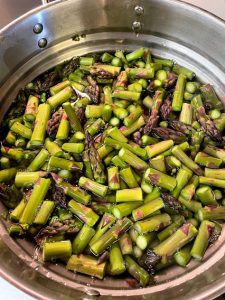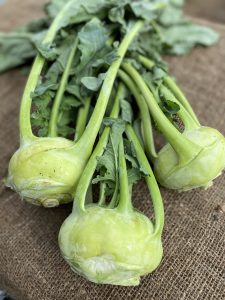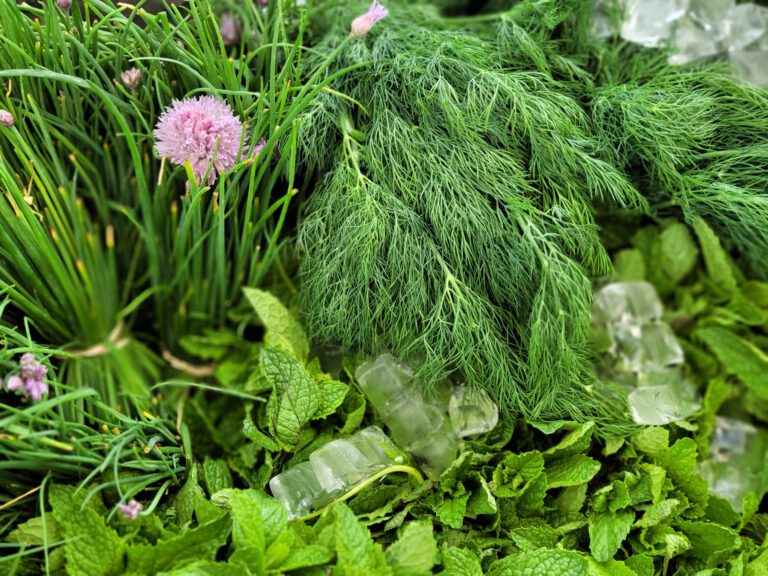Right now we have an array of fresh vegetables and herbs that are in season on our farm, such as; asparagus, spinach radishes, arugula, lettuces, leeks, parsley, cilantro, dill, & mint. These items are in abundance right now and you may want to consider storing some for use later in the year. We’ve put this handy guide together to help you savor eating in season this Spring. More guides will be published as various produce becomes available according to our harvest schedule. Want to learn more about what’s in season? Please visit our annual harvest schedule on our website
Keep some asparagus for the winter. The asparagus season starts in May and is in prime season for only a couple of weeks. Asparagus can be enjoyed in a variety of ways, including some recipes crafted by our culinary specialist, Miss Jenn.
 How to Freeze Asparagus
How to Freeze Asparagus
Prepare the following items:
- Bring 1 gallon of water per pound of asparagus to a boil
- Prepare an ice water bath ice
- Freezer containers / zip lock bags
- Clean the asparagus to remove any grit, soil, and snap or cut off the woody ends
- Bring the water to a boil, keep the heat on high and immerse the asparagus, water should come back to a boil in one minute
- Boil 1 ½ minutes for thin stems, 2 minutes for medium and 3 for fat.
- Immediately remove and submerge into the ice bath. This will stop the cooking process.
- When cold, drain, allow to dry on paper towels
- Pack in airtight containers or bags
If using bags, close the bag almost to the end. Stick a straw into the bag and draw out as much air as possible from inside the bag. Press down on the straw as you continue to close the bag and pull the straw out. Label and date bags or containers.
Freezing spinach, follow the same directions. Clean the spinach, (save stems for vegetable stock) remove tough stems, bring water to a boil, and add spinach, bring water back to a boil and
Time 3 minutes, remove quickly and submerge into the ice bath. Drain, set out to dry chop, or leave the leaf whole and pack in airtight containers.
Or freeze in ice cube trays and then remove to bags. Use the straw method to draw out as much air as possible when closing a zip lock freezer bag.
Remove the greens from the radish root. Store separately or together. The greens are tender, use within a couple of days. Radishes should last up to a week.
Use the same method for beets. Beet greens should be used quickly, the beet root will keep up to a week. Roasting beet will prolong your storage time and have them ready to add to salads during the week. Roasting whole beets: Wrap the beets individually in foil, set onto a baking pan and place in the oven at 400. Check to see if they are fork tender after 45-50 minutes. They can take over an hour depending on the size.
Kohlrabi- remove the leaves, store separately, use the leaves within a few days. Kohlrabi can last up to 2 weeks. Simple prep: peel and slice and lightly salt for an appetizer or snack. To roast, preheat the oven to 425, peel, thinly slice, place into a bowl, and add a sprinkle of salt and pepper and a little olive oil to coat and a Tablespoon of parmesan cheese. Spread out onto a parchment lined baking sheet in a single layer, roast for 12-15 minutes. Checking after 5-7 minutes. Kohlrabi should be fork tender and have lightly browned edges. Most Kale or collard recipes will work using kohlrabi leaves.
to 2 weeks. Simple prep: peel and slice and lightly salt for an appetizer or snack. To roast, preheat the oven to 425, peel, thinly slice, place into a bowl, and add a sprinkle of salt and pepper and a little olive oil to coat and a Tablespoon of parmesan cheese. Spread out onto a parchment lined baking sheet in a single layer, roast for 12-15 minutes. Checking after 5-7 minutes. Kohlrabi should be fork tender and have lightly browned edges. Most Kale or collard recipes will work using kohlrabi leaves.
To keep fresh herbs:
Wash herbs in cool water, remove dead stems and leaves, Snip the ends and gently pat dry. Place stems in a container filled with water, do not submerge the leaves. Changing the water daily will help to keep the herbs fresh. They can keep up to a week on the counter or cover the container with a plastic bag and refrigerate. Change water if it becomes murky. Most fresh herbs (not basil) will last more than a week when stored this way.
Herbs that are dried in your own kitchen will have much better flavor than those that you purchase in the supermarket and it is so easy to dry herbs in your oven. To do so place leaves or seeds on a baking pan with sides not more than 1 inch deep in an open oven at low heat less than 170 for about 2 to 4 hours. Leaves will be dry, brittle, they may crumble when you touch them. Allow the herbs to cool and then pack them in jars label and date.
Home dried herbs will last for years and they do make great hostess gifts.
Both herbs can be used in salads, salad dressings, marinades, use leeks to garnish any potato dish and soup. Use cilantro in tacos, prepare cilantro pesto for use with grilled chicken served with southwestern accompaniments. Add cilantro to black beans.
Prepare herb butter and freeze for a way to keep your herbs fresh. Herb butter is also known as compound butter. Chop fresh herbs and combine with room temperature butter. If you are using fresh herbs, rinse them thoroughly and allow them to air dry for several hours prior to chopping. Spoon mixture onto plastic wrap then form into a log and place in the freezer. Remove from the freezer when ready to use and slice. The varieties are endless, try mixing garlic, rosemary, parsley, thyme with lemon for salmon or mix basil, parsley, oregano, rosemary for steak. You may also make compound butter from your dried herbs if preferred. Experiment with your fresh or dried herbs and your preferences to what combination you can come up with.
Tag us in your photos to share your creations!
Best wishes from our farm kitchen to yours!







